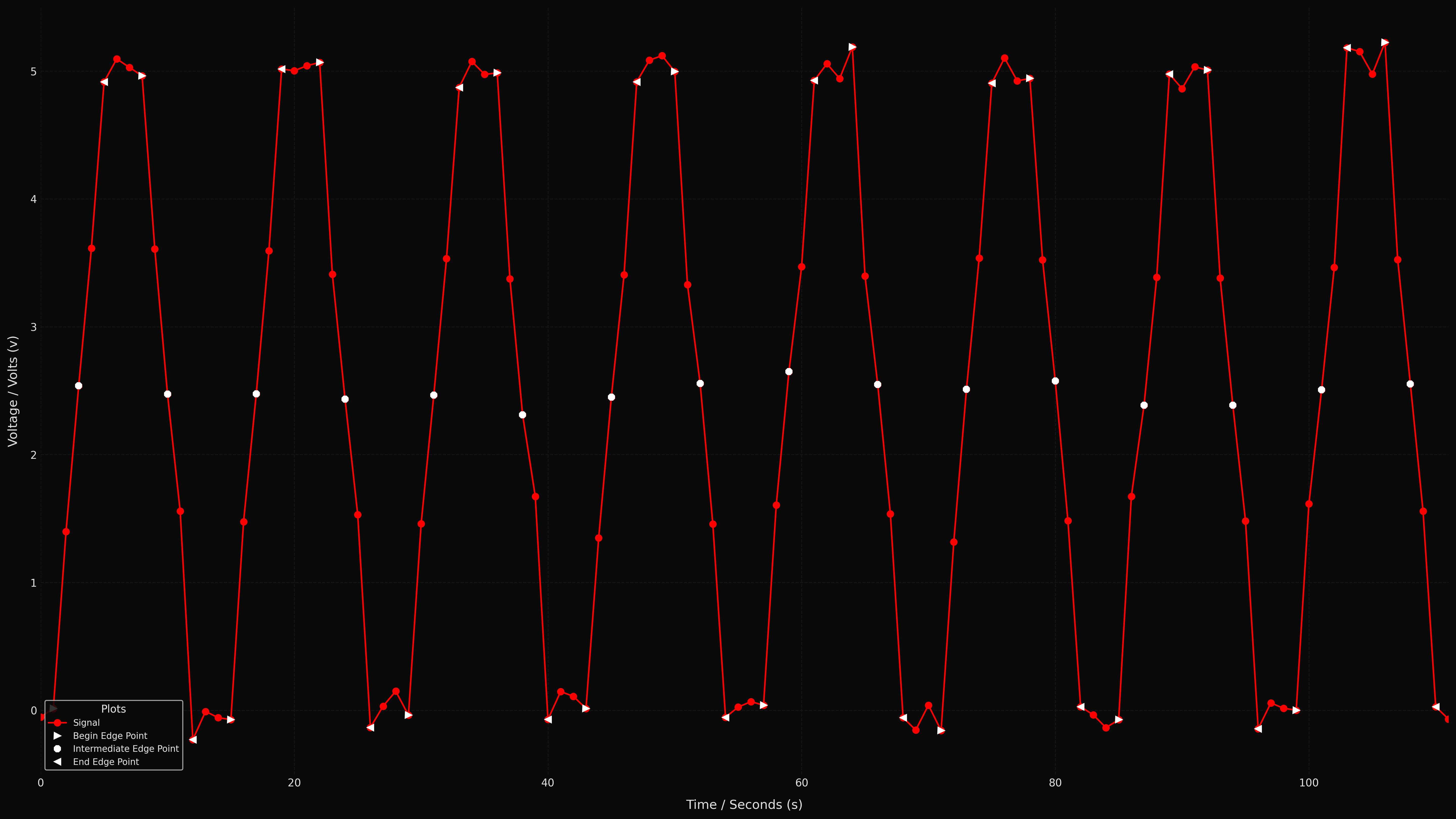Edges
The edges mixin, EdgesMixin, can be added to Signal to obtain different types,
Type, of edges of a signal. Each of the resulting edges are returned as a Edge.
To configure how to calculate the intermediate point of the edge, refer to IntPointPolicy.
The edges mixin requires the StateLevelsMixin to also be added to the signal, the code snippet below shows
how to add the edges functionality to a signal:
import signal_edges.signal as ses
class ExampleSignal(ses.state_levels.StateLevelsMixin, ses.edges.EdgesMixin, ses.Signal):
pass
An example of its usage using VoltageSignal is described below:
import numpy as np
import signal_edges.signal as ses
# Create timestamps for the signal.
signal_timestamps = np.linspace(start=0, stop=112, num=112, endpoint=False)
# Create voltages for the signal, and add some noise to them.
pattern = [0, 0, 1.5, 2.5, 3.5, 5, 5, 5, 5, 3.5, 2.5, 1.5, 0, 0]
signal_voltages = np.asarray(pattern * (112 // len(pattern))) + \
np.random.normal(0, 0.1, 112)
# Create signal.
signal = ses.VoltageSignal(signal_timestamps, signal_voltages, "s", "V")
# Obtain state levels.
(state_levels, _) = signal.state_levels()
# Obtain edges.
edges = signal.edges(state_levels)
# Plot edges.
signal.edges_plot("signal.png", edges)
This code snippet generates the following plot:

The generated signal with the edges begin, intermediate and end points marked.
- class EdgesMixin
Edges mixin for
Signalderived classes that implements the calculation of edges in a signal.Caution
This mixin requires the
StateLevelsMixinin the signal derived fromSignal.- __init__(*args, **kwargs)
Class constructor.
- edges(levels, int_policy=IntPointPolicy.POLICY_0)
Extracts the edges in the signal from the state levels given.
- Parameters:
levels (
StateLevels) – State levels.int_policy (
IntPointPolicy) – The policy to use for intermediate point calculation.
- Raises:
EdgesError – Invalid state levels.
EdgesError – Assertion error in the algorithm for the signal provided.
- Return type:
- Returns:
The edges found in order of appearance in the signal.
- edges_to_array(edges, array_id)
Converts values in a sequence of edges to relevant arrays.
Note that for
intermediate, if two edges share the same intermediate point, two times that value will be included in the array to keep the length of the arrays consistent.- Parameters:
- Raises:
EdgesError – The sequence of edges given has no edges.
EdgesError – The array identifier provided is not valid.
- Return type:
tuple[ndarray[Any,dtype[float64]],ndarray[Any,dtype[float64]]]- Returns:
The values of the horizontal axis and the values of the vertical axis for the sequence of edges.
- edges_plot(path, edges, *args, begin=None, end=None, munits=0, points=(), **kwargs)
Performs a plot of the edges of the signal.
- Parameters:
path (
str) – The path where to store the plot, seePlotter.plot().edges (
Sequence[Edge]) – The edges to plot, if there are no edges, then no points will be plotted for edges.args – Additional arguments to pass to the plotting function, see
Plotter.plot().begin (
Optional[float]) – The begin value of the horizontal axis where the plot starts, seePlotter.plot().end (
Optional[float]) – The end value of the horizontal axis where the plot ends, seePlotter.plot().munits (
float) – Margin units for the plot, seePlotter.plot().points (
Sequence[Literal['begin','intermediate','end']]) – The type of edge points to plot, defaults to all edge points.kwargs – Additional keyword arguments to pass to the plotting function, see
Plotter.plot().
- Return type:
Self- Returns:
Instance of the class.
- class IntPointPolicy
Policies that dictate how to calculate the intermediate point of edges.
By default, the intermediate point of any edge, both normal or runt edge, is the point within the edge the nearest to the intermediate value in the
StateLevelsprovided by the user.This behaviour can be modified by using intermediate point policies.
- POLICY_0 = 1
Use the data point in the edge, including
beginandend, that is nearest to the intermediate level.
- POLICY_1 = 2
Force use of
beginfor falling edges andendfor rising edges.
- POLICY_2 = 3
Force use of
endfor falling edges andbeginfor rising edges.
- class Type
Type of an edge.
The
StateLevelsprovided for calculation of edges define the following logical areas for edges:The high area,
high_a, for values that satisfy value > high.The intermediate high area,
int_high_a, for values that satisfy intermediate < value <= high.The intermediate low area,
int_low_a, for values that satisfy low < value <= intermediate.The low area,
low_a, for values that satisfy value < low.The runt low area,
runt_low_a, for values that satisfy low <= value <= high_runt.The runt high area,
runt_high_a, for values that satisfy runt_low <= value <= high.
The runt areas and the intermediate areas overlap between each other, and the high and low areas do not overlap with any other area. The type of an edge is defined by how it transitions between these areas.
Runt edges can only be found in pairs, since until a
highorlowlogical level has been reached it is not possible to determine whether edges are truly runt edges or normal edges.- FALLING = 1
A normal falling edge, from
high_atolow_a.
- FALLING_RUNT = 2
A runt falling edge, from
high_atorunt_low_aor fromrunt_high_atolow_a.
- RISING = 3
A normal rising edge, from
low_atohigh_a.
- RISING_RUNT = 4
A runt rising edge, from
low_atorunt_high_aor fromrunt_low_atohigh_a.
- class Edge
Definition of an edge in a signal.
- Parameters:
edge_type – The type of edge.
ibegin – Index of the beginning of the edge in the signal.
hbegin – Value of the horizontal axis of the signal at the beginning of the edge.
vbegin – Value of the vertical axis of the signal at the beginning of the edge.
iintermediate – Index of the intermediate point of the edge in the signal.
hintermediate – Value of the horizontal axis of the signal at the intermediate of the edge.
vintermediate – Value of the vertical axis of the signal at the intermediate of the edge.
iend – Index of the end of the edge in the signal.
hend – Value of the horizontal axis of the signal at the end of the edge.
vend – Value of the vertical axis of the signal at the end of the edge.
- exception EdgesError
Edges exception class.